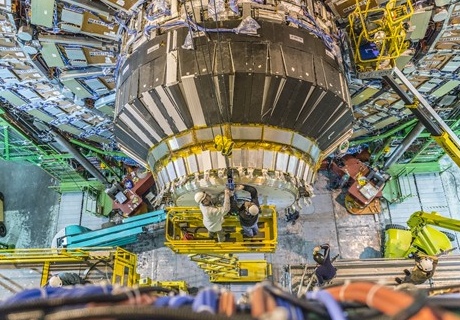
Large Hadron Collider (LHC) at CERN

Latest results from the detectors at CERN reveal that the Higgs boson particle continues to behave exactly as the Standard Model predicts.
According to the Standard Model, the Higgs boson particle gives mass to fundamental particles. Since discovery of the new particle in 2012 by the ATLAS and CMS Collaborations, particle physicists at CERN’s Large Hadron Collider (LHC) have been hard at work trying to confirm whether it is indeed the Higgs of the Standard Model, or perhaps just one of many Higgs bosons waiting to be found.
Writing up the most recent results was a lot of hard work but very satisfying. Seeing these studies brought to fruition is a true testament to the ingenuity and commitment of all involved, from those working on the machine to the final steps in these complex analyses
– Dr Chris Seez
Department of Physics
The confirmation process has included analysing results from a series of experiments, including the Compact Muon Solenoid (CMS) experiment, where one of the pioneers is Imperial’s Professor Sir Tejinder (Jim) Virdee.
Releasing their latest analysis from the First Run of the CMS experiment, the scientists, who include a team of physicists from Imperial College London, have confirmed with greater precision than ever before that the particle discovered in July 2012 behaves like the Standard Model Higgs boson.
To confirm that the Higgs boson works in exactly the way that the Standard Model predicts, scientists have been trying to study its properties in detail. The Higgs boson is a short-lived transitory particle that decays into pairs of lighter particles almost immediately after it is produced by the collisions at the LHC. Researchers have been trying to demonstrate that it decays into particles that give force (bosons), and particles that make up matter (fermions), which would verify its mass-giving ability.
The new data, along with results from ATLAS, which was revealed at the 37th International Conference on High Energy Physics, shows the strongest evidence yet that that the Higgs boson they found in 2012 decays to other particles as predicted. One of these decays happens when the Higgs transforms into two photons, and the latest CMS results investigating this decay channel show a definite peak in the data that demonstrates the decay happening in action. The probability that this is just a random occurrence is less than one in three million. And a recent CMS research paper published in Nature Physics demonstrated strong evidence of the Higgs boson decaying to fermions.
Taken together, these latest results finally confirm that the Higgs boson is decaying into fermions as well as bosons, with rates as expected, and so the Higgs boson predictions of the Standard Model are standing up exceptionally well.
Dr Chris Seez from the Department of Physics at Imperial College London has been searching for the Higgs boson since the 1980s. “Writing up the most recent results was a lot of hard work but very satisfying. Seeing these studies brought to fruition is a true testament to the ingenuity and commitment of all involved, from those working on the machine to the final steps in these complex analyses.”

CMS detector at CERN
As they wrap up the results of the First Run, physicists are now turning their attention to the Second Run, which starts in early 2015. By nearly doubling the energy of the accelerator, researchers hope to open a new window on physics beyond the Standard Model. The search is now on to find what lies beyond the Standard Model, including more Higgs bosons, supersymmetry and dark matter.
With a more powerful accelerator and upgraded CMS detector, Professor Gavin Davies, also from the Department of Physics who leads Imperial’s CMS group at CERN is looking forward to the potential discoveries on the horizon. “It is fantastic to see such progress from discovery to detailed study within two years, but this is just the beginning. There is a whole lot more to come.”
Professor Paul Dauncey, from the High Energy Physics Group at Imperial College London said: “ With the Second Run, as well as more detailed characterisation of the Higgs as a way to probe for new physics, there’s real discovery potential for new particles. I can’t wait for the LHC to be fired back up again.”
Researchers from Imperial are not only behind the pre-eminent Higgs theory, but also amongst those who designed, engineered and built the CMS detector of the Large Hadron Collider at CERN. Emeritus Professor Sir Tom Kibble, whose work led to the prediction of the mass-giving particle, and Professor Sir Jim Virdee, who led on the design and construction of one the detectors that found the Higgs boson, both received knighthoods in the 2014 Queen’s Birthday Honours list.
Article text (excluding photos or graphics) © Imperial College London.
Photos and graphics subject to third party copyright used with permission or © Imperial College London.
Reporter
Gail Wilson
Communications and Public Affairs

Contact details
Email: press.office@imperial.ac.uk
Show all stories by this author




Leave a comment
Your comment may be published, displaying your name as you provide it, unless you request otherwise. Your contact details will never be published.